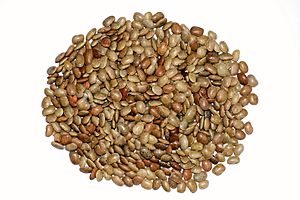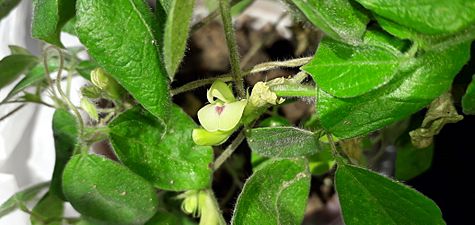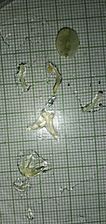Horse gram facts for kids
Quick facts for kids Horse gram |
|
|---|---|
 |
|
| Horse gram seeds | |
| Scientific classification | |
| Varieties | |
|
|
| Synonyms | |
|
Horse gram (scientific name: Macrotyloma uniflorum) is a special type of legume. It's also known by names like kulthi bean, gahat, hurali, or Madras gram. This plant is originally from tropical southern Asia.
Horse gram is famous for its unique taste and texture. People use it in many different foods. It's also known for being very nutritious and having health benefits. Farmers often grow it to feed horses, which is how it got its name. You can find horse gram growing in parts of India, Nepal, Malaysia, Sri Lanka, and even the West Indies. People eat it whole, sprouted, or ground into flour. In India, it's sometimes called a "superfood." Some Hindus eat it to get important nutrients, especially during fasting days. Ancient Indian medicine, called Ayurveda, also talks about its health uses.
Contents
What is Horse Gram?
Horse gram is a plant that can grow back year after year. It's a climbing plant that reaches about 60 centimeters (2 feet) tall. It has a special underground stem called a rhizome. New stems grow from this rhizome each year.
The stems have soft, whitish hairs. Its leaves are made of three smaller leaflets. These leaflets can be up to 7 centimeters (3 inches) long. The flowers grow in groups of two or three. They look like typical bean flowers, with cream, yellowish, or green petals. Sometimes they have a purple spot inside. After the flowers, long, curved pods grow. Each pod can be up to 8 centimeters (3 inches) long. Inside, there are up to ten reddish-brown, speckled, or black seeds.
Where Horse Gram Grows
Horse gram first came from tropical southern Asia. Scientists have found its remains in India from as far back as 2500 BC. It was likely first grown by people in India. Today, it's grown as a legume from India all the way to Myanmar. Farmers also grow it in tropical parts of Southeast Asia and northern Australia. They use it to feed animals (fodder) or to improve soil (green manure).
This plant loves warm weather, usually between 20 to 30 degrees Celsius (68 to 86°F). Cold frost can kill it. Horse gram is very good at handling dry conditions. It grows well in places with less than 900 millimeters (35 inches) of rain. It can even survive with as little as 380 millimeters (15 inches) of rain. In wetter areas, farmers often plant it at the end of the rainy season. This way, it grows and produces crops during the dry season.
Nutritional Benefits of Horse Gram
Horse gram is a very healthy legume. It's similar to other beans you might know. It has lots of good things for your body. For example, it's an excellent source of iron and molybdenum. These are important minerals.
Horse gram seeds contain about 57% carbohydrates, 22% protein, and 5% dietary fiber. They also have a small amount of fat (0.5%). In every 100 grams of dry horse gram, you get about 287 mg of calcium and 311 mg of phosphorus. It also provides vitamins like thiamine, riboflavin, and niacin. The amount of nutrients can change a bit depending on the soil and weather.
Scientists have found that horse gram seeds have natural plant compounds called polyphenols and flavonoids. These are like tiny superheroes that help protect your body.
Horse Gram in Indian Cuisine
In India, horse gram is known by many names like ulavalu, gahat, muthira, kulath, or kulthi. It's used to make many popular dishes.
- In Telangana and Andhra Pradesh, people believe horse gram helps with iron problems. A popular soup called Ulavacharu (horse gram soup) is often served at weddings.
- In Darjeeling and Sikkim, horse gram (called gahat) is seen as a healing food. Some people drink water where gahat has been soaked. They believe it helps with kidney stones. It's especially popular in cold winters because it's thought to make you feel warm.
- In Kerala, horse gram is called മുതിര (muthira). It's used in special local dishes.
- In Tamil Nadu, it's called கொள்ளு (kollu) or காணம் (kaanam). People use it to make kollu chutney, kollu porial, kollu avial, kollu sambar, and kollu rasam.
- In Maharashtra and Goa, horse gram is called हुलगा (hulage/hulaga/kulith). It's used to make dishes like aamati and kulith usal.
- In Karnataka cuisine, it's called ಹುರಳಿ (hurali). It's a main ingredient in dishes like ಹುರಳಿಸಾರು (hurali saaru), usali, and chutney.
- In Odisha, it's known as କୋଳଥ (Kolatha).
- In the Pahari region of northern India, gahat or kulath is a key food. In Himachal Pradesh, it's used to make khichdi. In Uttarakhand, it's cooked to prepare ras and phanu, which are popular local dishes.
In Myanmar (Burma), horse gram is called pe bazat (ပဲပိစပ်). It's often used to make pon ye gyi, a fermented bean paste used in traditional Burmese cuisine.
Medicinal Uses of Horse Gram
Scientists have studied horse gram for its health benefits. Researchers from the Indian Institute of Chemical Technology found that raw horse gram seeds can help with high blood sugar. They also found that these seeds can help the body use insulin better. Insulin is a hormone that controls blood sugar.
The scientists compared raw seeds with sprouts. They found that the raw seeds had even more health benefits for people with high blood sugar. Most of the helpful plant compounds, called antioxidants, are found in the seed coat. So, it's best to eat the seeds with their coats on. Horse gram seeds are rich in natural antioxidants like polyphenols and flavonoids. These are the same helpful compounds found in many fruits. The seeds can help lower blood sugar after meals. They do this by slowing down how your body digests carbohydrates.





